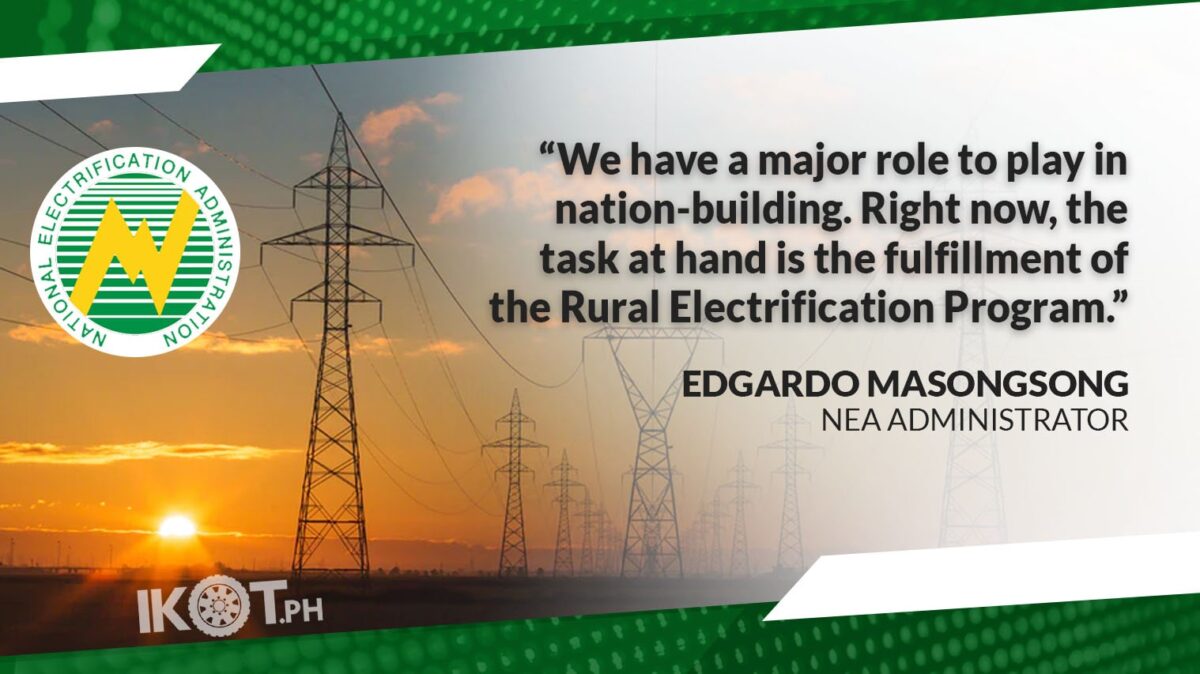State-run National Electrification Administration (NEA) exhorted the 121 electric cooperatives (ECs) to increase efforts towards the completion of the government’s rural electrification program.
NEA Administrator Edgardo Masongsong made the statement Tuesday, December 1, at the 41st Annual General Membership Meeting (AGMM) and Year-end Strategic Conference of the Philippine Rural Electric Cooperatives Association, Inc. (PHILRECA).
“Rural Electrification is not just about construction of lines reaching the last household in the EC franchise area. It is about social and economic development in the countryside. It is about sustainable rural development through rural electrification.”
In his message, Masongsong reaffirmed the agency’s commitment to total electrification, adding that they can achieve this goal if they continue to work together.
“We have a major role to play in nation-building. Right now, the task at hand is the fulfillment of the Rural Electrification Program,” the NEA chief told delegates of the PHILRECA AGMM, which was held virtually.
“Rural Electrification is not just about construction of lines reaching the last household in the EC franchise area. It is about social and economic development in the countryside. It is about sustainable rural development through rural electrification,” he added.
Masongsong admitted that the agency needs additional government subsidy to implement the Sitio Electrification Program (SEP) in the coming years, as there are over 12,000 sitios nationwide yet to be energized.
The NEA, together with the 121 ECs as the implementing arm of the government’s rural electrification program, has already identified several measures in order to meet the full energization target by 2022.
The NEA, together with the 121 ECs as the implementing arm of the government’s rural electrification program, has already identified several measures in order to meet the full energization target by 2022.
These include accessing the Energy Regulation No. 1-94 program, availing foreign grants and donations, using EC’s internally generated funds, or entering into a qualified third party agreement.
“Under the Qualified Third Party program, electric cooperatives can waive a part of their unviable areas to qualified private investors,” Masongsong said, adding that if there are no takers, the National Power Corp. (NPC) may implement these projects through missionary electrification.
The NEA administrator said other options are allowing the power co-ops to implement the electrification program as part of their capital expenditure projects plan, or tapping renewable energy sources to bring electricity to areas still in the dark.
Meanwhile, NEA Deputy Administrator for Technical Services Artis Nikki Tortola said that from 2011 to 2019, the state-run agency through its partnership with the ECs has energized a total of 38,357 sitios across the country. To date, about 12,467 sitios, however, still have no electricity.
“Latest data would show that we still need to energize 12,467 sitios. While the agency recommends (electrification) targets to be budgeted by the Department of Budget and Management, only a meager allocation is being given to the agency,” Tortola said Wednesday (December 2) at the PHILRECA AGMM.
Based on the 2021 National Expenditure Program (NEP), only P1.6 billion is appropriated for the sitio electrification projects. The amount, however, will only benefit 1,085 sitios in the country.
Hence, the NEA earlier welcomed the House resolution filed by the Power Bloc representatives in September that seeks to restore P9 billion in the agency’s proposed budget for 2021.
Aside from the Sitio Electrification Program (SEP) and Barangay Line Enhancement Program (BLEP), the NEA also has other ongoing projects to energize areas that cannot be connected to the grid.
The NEA’s Strategized Household Electrification Program (SHEP) targets dispersed households located in far-flung areas with no access to the grid through the use of stand-alone photovoltaic (PV) systems.
Under this program, the NEA has identified 5,039 household beneficiaries in the coverage areas of Busuanga Island Electric Cooperative, Inc. (BISELCO), Camarines Sur IV Electric Cooperative, Inc. (CASURECO IV), Iloilo III Electric Cooperative, Inc. (ILECO III), Cotabato Electric Cooperative, Inc. (COTELCO), and Zamboanga del Norte Electric Cooperative, Inc. (ZANECO).
The NEA’s Strategized Sitio Electrification Program (SSEP), on the other hand, targets isolated sitios that cannot be energized by either sitio electrification or barangay line enhancement programs.
Tortola said SSEP involves two components: the conduct of a feasibility study and the development of a hybrid microgrid system. “A feasibility study is necessary to identify which renewable energy resource is the most advantageous to use,” he said.
Under this project, the NEA has identified three ECs that are currently undergoing feasibility studies. These are the Quezon II Electric Cooperative, Inc. (QUEZELCO II), South Cotabato II Electric Cooperative, Inc. (SOCOTECO II), and ZANECO.
Aside from these projects, the NEA is also implementing a Schools Electrification Project with the Batangas II Electric Cooperative, Inc. (BATELEC II). This project aims to provide 10 schools with solar panels installed within the school’s premises and connected to the distribution system through the Net Metering Program.
The agency also announced the nearing completion of the feasibility studies for the hybridization of the existing diesel power plants with renewable energy and battery in 10 islands in Northern and Western Samar. The project is in partnership with the National Economic and Development Authority (NEDA).

